How are you feeling right now?
Like really...how are you doing?
If you're like most people I've spoken to, things are pretty rough with quarantine continuing. You may be feeling it, and there is likely some employee burnout on your team.
An informal poll of my followers on Twitter showed that over 2/3rds of respondents are already feeling burnout symptoms, or feel fully burned out now.
Are you feeling lockdown burnout at all?
— Jason Evanish (@Evanish) May 7, 2020
Symptoms include: fatigue, difficulty focusing, poor sleep, overworking, significant drop in productivity, overall malaise.
Something's got to give.
Quarantine, lockdown, and all the uncertainty around Coronavirus is impacting us all in a variety of challenging, and potentially damaging ways.
One of the most interesting is the distortion of time.
A friend and I were chatting about the impact and how it felt like "Groundhog Day" over and over (see the Bill Murray movie from 1993 if you don't get the reference).
Their response?
"I joke with my partner that it's March 82nd."
This isn't far from the truth. According to E. Alison Holman, Ph.D., a psychologist and an associate professor at UC Irvine, this is a common phenomenon right now:
"People lose track of time when the future is in question...The continuity from the past to the future is gone. That's what they are experiencing right now.”
However, it's more than time that feels off to us; we're all under a variety of ongoing, unrelenting stressors:
- Constant, anxiety-inducing news of an ever rising number of cases and deaths.
- Fear for your own job and your company's prospects as approximately one million people lose their job in America each workday we're in quarantine.
- Frustration over the politicization of news and tons of conflicting information about the virus, its harmfulness, and treatments.
- Personal challenges, whether living alone and feeling isolated, helping your young children navigate their disrupted schedules, providing education for your school age children, or confronting any number of marital challenges you cannot get away from.
With all of this happening, it's sadly not surprising that one hospital even in affluent Walnut Creek, California is reporting that attempted suicides are larger in the last 4 weeks than *all of last year*.
I hate to have this much doom and gloom in a Lighthouse blog post, but it's important to capture the seriousness of the issue and what may be hiding under the surface. The cost of employee burnout is high.
Helping yourself and your team avoiding burnout and deal with the other psychological stressors of quarantine may not just be good for productivity, but you could be saving a life.

Helping Yourself and those Around You in Avoiding Employee Burnout
Even a few weeks ago, cracks were already showing. According to a survey by Qualtrics + SAP reported in the Harvard Business Review:
"Since the outbreak of the pandemic, 75% of people say they feel more socially isolated, 67% of people report higher stress, 57% are feeling greater anxiety, and 53% say they feel more emotionally exhausted."
So what can you do as a leader to help relieve this and avoid employee burnout?
Lead by example by trying some of these tactics below. Then, work with your team members to see how they're doing and encourage them to try some of these. They can keep what works and keep iterating on what doesn't.
Table of Contents:
- Make breaks okay, and enforce your boundaries
- Work on your workspace and mental health routines
- Give some control back in their lives
Whether you're trying to prevent employee burnout, or are helping some with reversing burnout they're already feeling, these can help people return to a better state of mind.
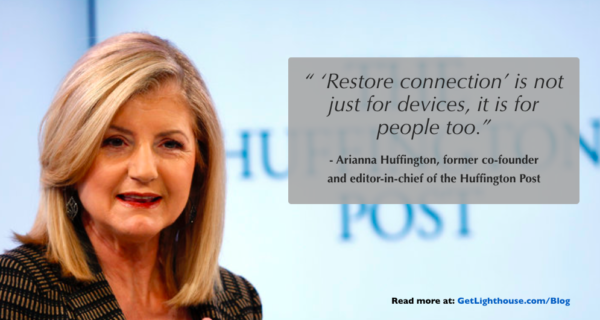
1. Make Breaks Okay, and Enforce Your Boundaries
When you're at work there are all kinds of routines, habits, and structure that create a healthy workday, and an enjoyable workplace:
- You have a daily commute to warm up and wind down each day
- There is a set time you see everyone leave work
- You have random times to connect with friends at work at lunch, in the kitchen and hallways, and on your way to and from meetings
In addition to all that, work is for...work.
Meanwhile, working from home, you're in an environment where:
- All your fun and distracting things about your life are all around you.
- Your spouse, partner, children, pets, and others are all in potentially close quarters and looking for attention...or space.
- You don't see any of your friends.
- There's no clear stopping or starting work time except what calls may be on your calendar.
With all of that happening, it's easy to feel "always on". You don't get the natural breaks in your day, and it becomes super tempting to respond to emails and chat messages at any hour of the day.
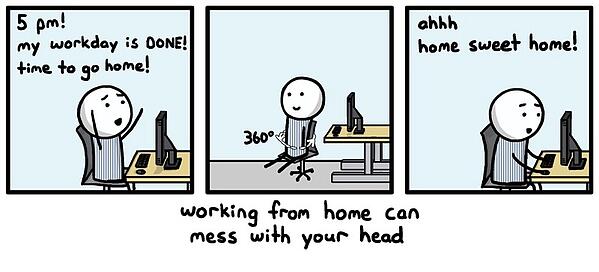
Take breaks throughout the day, and have a clean end to your day.
One of the biggest slip ups I see people have with their transition to working from home is the lack of breaks in their day. It's so easy to just keep plowing through more work, more calls, and more documents.
Even a bio break may only be a few steps away, so does not provide the same rest a short walk across your office would.
Instead try some of these things:
1) Get outside for some sunlight
A Lighthouse reader shared this great video above that highlights a variety of tactics that can help, best of which is sunlight (starts at 3:40).
As the video shares, sunlight is a great source of Vitamin D, it helps regulate your sleep cycles, and releases the mood enhancing serotonin.
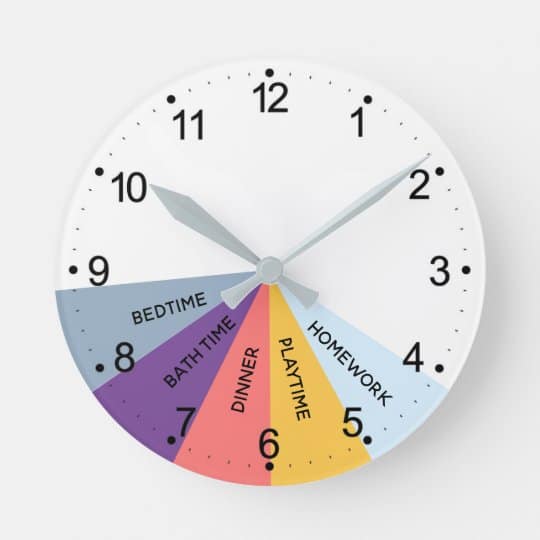
2) Shift their work hours
With the extra challenges of potentially sick family members, small children to care for, and kids to provide schooling for, many people's schedules are quite strained. Whether you are a single parent home or a household with two parents working, this can get challenging fast.
I asked my Twitter followers for advice and the whole thread is filled with good advice, with the best coming from Misha Chellam, founder of the Council on Technology & Society:
Set routing for splitting time (2-3 hour blocks from 7am to 5:30pm). One night each week where other parent takes bedtime, you can walk around or do whatever. FaceTime w friends & family during the day. Low education bar, focus on child care mainly. Less drinking, more exercise
— Misha Chellam 🇺🇸 🏗️ (@mishachellam) May 4, 2020
Is there a block of time for their work where it doesn't matter if they're online and can work late at night instead? Is there a meeting you can shift that would really help them out?
Balancing these challenges can be very hard. One way to really help your team members is to find ways to allow them to tweak their schedule based on their family demands, while not missing anything critical with your team.
3) Call a friend
Leadership coach and best selling author Ken Blanchard has a great, quick tip to call old friends:
Here's a fun question: As a result of this quarantine, what are you OVER and what are you INTO? I'll tell you mine if you tell me yours! pic.twitter.com/TaGg3JdfZw
— Ken Blanchard (@kenblanchard) May 8, 2020
I have caught up with friends all over the world during quarantine. The best thing in all of this is that we're all in this together, so everyone is happy to hear from friends and to catch up.
Even a quick 15 minute chat can boost your mood, especially if you're living alone and craving some connection.
4) Look for opportunities to volunteer and help others
Volunteering isn't just good for the resume. It actually makes us happier when we help others:
People who volunteer are happier, but is that because 😄 people volunteer or does volunteering make you 😄?
— Ethan Mollick (@emollick) May 16, 2020
This paper in the wonderfully-named Journal of Happiness Studies finds volunteering leads to 😄. The average volunteer gets happiness equivalent to a $1.1k salary boost! pic.twitter.com/mjKIuZb8qw
At a time like this, there may be fewer ways to volunteer, but with food banks overwhelmed and many places desperately needing blood, the opportunities that do exist can make a huge impact.

5) Take time to exercise
I miss the gym. I miss playing soccer. I miss playing with my friends. If you had a solid exercise routine you probably miss those things, too.
Unfortunately, it does not look like gyms, team sports, or in person group classes are coming back any time soon in many affected areas, especially if you live in a city.
That means you have to adapt.
As the video on "How to Stop Being Tired" above mentions, exercising 3 times a week for 20 minutes is enough to boost your mood and energy levels significantly.
If you've been missing the gym and other fitness activities, it's time to adapt.
If you have kids, a family walk, or breaking out the jogging stroller can be a great way to involve your children with some healthy exercise. Meanwhile, if you're cramped in an apartment, you may be amazed what you can do with body weight exercises, like this bed sheet move (which I've tried and it works!):
You can also make this fitness routine a fun challenge as our head of engineering is trying to rise in the rankings on a hill he runs up on Strava, and I've been doing track workouts trying to break 6 minutes in the mile for the first time in years.
Whatever your team member is into, there are options to try that are solid exercise:
- Miss the gym? Try body weight workouts.
- Miss group classes? Try a class on Youtube or one of the trainers that have moved to Zoom classes.
- Miss a sports team? Try running, track workouts, or biking.
With a little creativity, and a willingness to try new things, you can adapt to the many exercise constraints of today. I've been amazed how much better I feel running twice a week, and doing body weight workouts 3-4 times a week, all while ensuring I get a couple hours of sun each day.
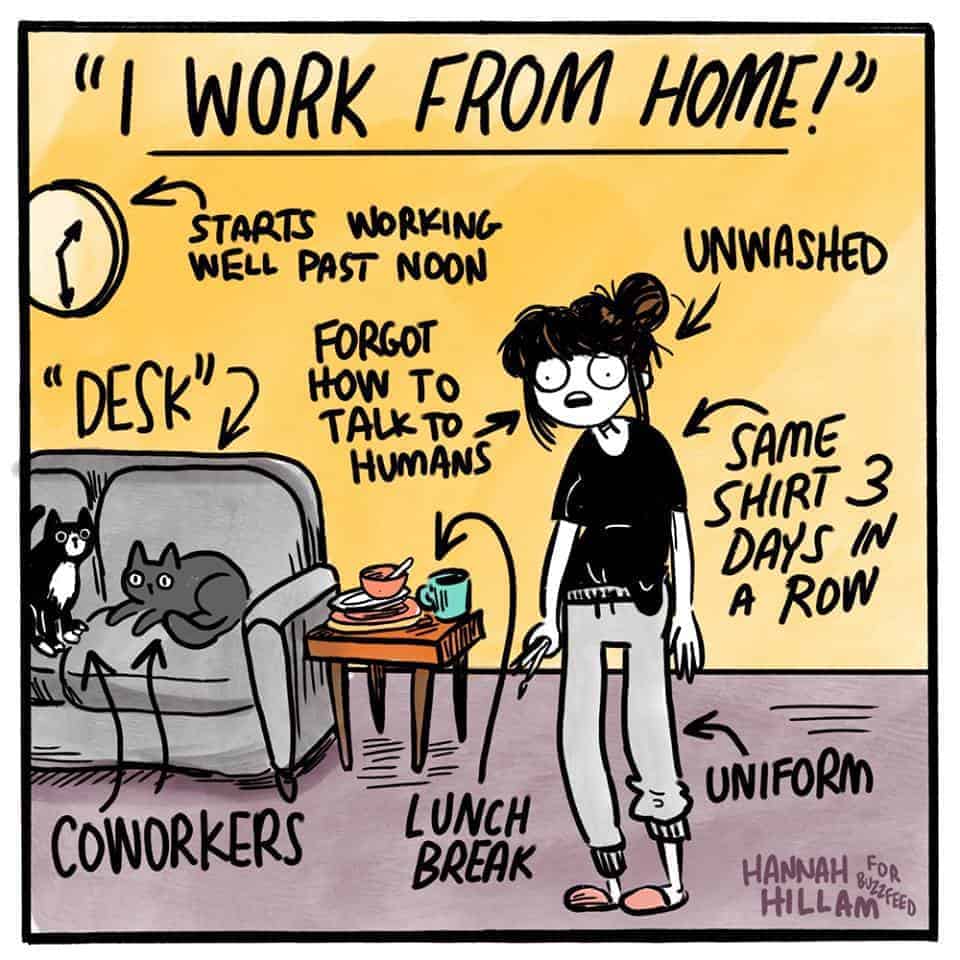
2. Work on your workspace and mental health routines
The physical side of preventing employee burnout is really important, but it's not he only thing to focus on.
Mental health and the configuration of your workspace makes a big difference, too.
This video captures well the challenges of quarantine both mentally and physically:
As you can see in the video, you have to have both sides taken care of to thrive. To make sure the mental aspect of avoiding burnout is in order, keep these tactics in mind:
1) Create a great, dedicated workspace in your home
Everyone's home is a little different. You may be one of the lucky few to have a dedicated office that you can go into and focus. However, for many people, that's not the case.
Instead, you have to get creative.
Even a small space carved out can make a big difference.
For example, in my small New York City apartment, my work desk is tucked in a corner next to my TV. Believe it or not, this creates enough space from my couch that I feel different depending on if I'm at my desk working or relaxing on the couch.
The key to all of this is that spaces are defined for certain purposes. I have my corner desk for work, my bedroom for sleeping, my couch for relaxing, and my kitchen for cooking.

What if I don't have space for everything?
One of the easiest things to do in quarantine is make excuses. "I can't do X," or "Y doesn't work for me."
You have to get creative.
One of the simplest and most powerful lessons I learned was from Rae Lambert in her blog post, "WFH Tips—Your space isn't the problem (aka how to not take calls from the bathroom)":
"My husband was a bit resistant to spending the 20-30 minutes to strategize where we should each set up our workstation.
I eventually convinced him to brainstorm with me and move some furniture around to make sure we had the best possible setup (still not great, let's be honest).
Figuring out the right setup was totally worth the time and just remember that whatever changes you make don't have to be permanent."
Just because you have limited space doesn't mean you can't re-use it in creative ways. That works whether you're creating a temporary office you set up daily, or a part time gym.
3 times a week I turn my living room and part of my kitchen into a body weight gym by making a few simple changes:
- I move my coffee table to the corner, creating a big center space for pushups, and lunges.
- I set a pad on the floor for ab workouts.
- I hang a knotted bed sheet over my bathroom door for face pulls, and rowing exercises (like the Youtube video above).
Best of all, I've found the ritual of setting up the room for exercise is a great way to transition my mind from working to working out, and then back again.
For more on helping your team with their work setups, or improving your own, check out:
- Anne-Laure Le Cunff's article on making an awesome work from home space.
- Be sure to ask your team these 3 questions and learn more about supporting your team's workspace in our post here.
2) Embrace new rituals & routines
As the video discusses, routines are especially important for sleep. You can't be effective and productive if you get insufficient or low quality sleep.
That's why you want to have a dedicated work setup, even if that means setting up a workspace and tearing it down end of day, because you live in a tiny apartment. It's also why the video then recommends you have different spaces for each activity in your home.
Structure your day and hold yourself accountable to it. I have hard rules of when I check in w/myself, meditate, do music things, write, read & work out. Now that we can’t location switch self discipline is key. I started by scheduling it all in my calendar and it’s a muscle now
— Pardees Safizadeh (@Pardees) May 8, 2020
Rituals are similar to the idea of the progress principle: it gives you a sense of forward movement, of purpose or meaning to the day, where before there was none.
Creating a strict schedule/ritual for waking, breaks, types of work, time off, sleep, etc can help you feel less of that time distortion that affects many people in quarantine.
This is also the single best thing parents can do for their kids, too.
A daily schedule/ritual for children gives them a sense of stability that tempers and occupies them. As a coworker at Lighthouse told me, this makes it much easier to focus and get work done as it helps avoid any meltdowns for young children.

Try meditation or breathing exercises.
You can get a clearer and more calm mind from any basic mindfulness practice. Even 10 minutes a day can really make a big difference.
Most of us are dealing with a lot of uncomfortable feelings right now, but the self-awareness that comes from meditation has a kind of magical quality to help with those thoughts and feelings.
By acknowledging them, and allowing your mind to relax, it can be easier to regain focus for whatever your next task or challenge is.
The Lighthouse team is fully remote, and so I wanted to share a lesson one of our team members told me about this:
"A few years prior to working remotely, I had gradually shifted my night owl schedule to rising early. It wasn't until later when I started to lax that schedule while working remotely that I realized how important my morning ritual had become to the rest of my day.
It was harder to focus and the day just seemed to slip by, like I suddenly lost all direction and stability.
I was more disoriented, more tired, frustrated, and stressed.
However, when I got myself back onto a solid schedule, this time not rising quite as early but still sticking to a set schedule with the same daily ritual, everything fell back into place.
I woke up at the same time, got to work at the same time, took a break same time in the afternoon, got off at the same time and spent the same block of time each night with family (and usually a short block at night after they went to bed).
Doing this, I felt good, woke up focused, and had a sense of direction and stability that helped make me feel like I was in control of my day again.
It's so easy to let your daily ritual melt down into nothing when you're working remotely. Really, as long as you get your work done, what does it matter?
It matters a lot, because without that ritual you don't get it done and you don't last. One day you wake up late, another you start late, or decide to take your break early, or get off early.
Before you know it you're waking up each day with the brakes on, and you can't seem to get yourself going.
And what makes all this click for them? Meditation.
The whole act of meditation triggers my day more than anything.
At the time, I was meditating for 30 minutes first thing in the morning. I didn't go into the practice with any intention, but just with the way the practice works, inevitably I'd end often up slogging through yesterday's thoughts, settling my mind, then shifting my focus to that day by the end of it.
It really allowed me to organize my mind and put me into a state of focus. By the time I was done, I felt ready to go.
Getting into meditation isn't easy for everyone, but fortunately, there are a few options:
- To learn how to meditate and a 7 other options for relieving workplace stress, check out our post here.
- Instead of meditation, a healthy breathing exercise can have similar, positive effects.
- Another option is the Relaxation-Response technique, which is my personal favorite and I find is also helpful in falling asleep at night.
And for any friends or former colleagues that have been laid off, Headspace has a tremendous offer:
Headspace is offering a free 1-year subscription for all unemployed Americans. So damn proud of this company. https://t.co/mvKG4Xk9j2 pic.twitter.com/0Qvsl4EvIy
— Frank ☼ Bach (@zendadddy) May 14, 2020
3. Give them some control back in their lives.
Two words that should scare managers more than any other are "Learned Helplessness."
In a nutshell, it's the unfortunate effect that if too many bad things that happen to someone are beyond their control, they will lose hope.
When they lose hope, this leads to plummeting productivity, disengagement, frustration, and dark thoughts like suicide.
Today, this is more true than ever:
- You have no say in whether your city or town is in lockdown.
- You can't help your friend who may have lost their job at no fault of their own.
- There are many things you may like doing that you're not permitted to do.
- Depending on your company's prospects, they may feel their job and the company is hopeless.
Fortunately, as their manager you can help.
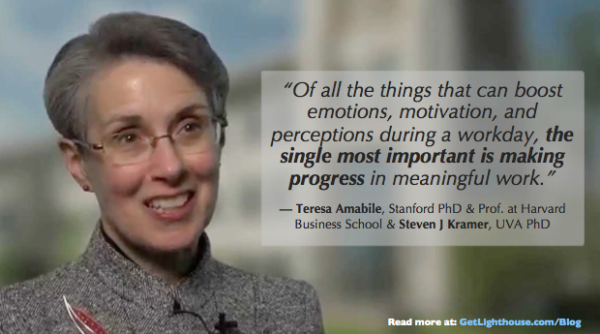
Give them some control and autonomy
Two studies show us the way to helping our teams avoid feeling learned helplessness all around them.
Teresa Amabile and Steven Kramer's research found that making real progress on a daily basis gives a huge boost to your mood.
And Dan Pink's TED Talk above shows us that autonomy is one of 3 key motivators for knowledge workers.
When you combine the two, you create motivational magic.
Make sure everyone on your team has ways to get small wins every day. If you're on one of those projects from hell with no end in sight, then think about milestones you can celebrate along the way. Every little bit helps.
Meanwhile, with autonomy, this is where you need to trust your team. Give them the ability to make some decisions about their work. Set the goal with them and hold them accountable, and then leave them to:
- Decide what tools they use to complete the project.
- Choose their work schedule as long as they get their work done (within reason for your company and team).
- Provide an update to you in the way they like best (video, document, email, etc) at the frequency you need.
I've always been amazed how having even one small part of my life feeling in control can make it easier to handle uncertainty in other areas.
Do not underestimate what even a little bit of a feeling of control can do to raise morale for a struggling team member. Look for ways to provide that in their work since they can't control a lot of other things right now.
7/ Zoom calls tend to stack on top of each other to the minute; whereas physical meetings 3 months ago required travel time, even if just for 100 feet…….which we now realize was a time to have a mini-decompression.https://t.co/NAcVwNNavB
— Ryan Caldbeck (@ryan_caldbeck) May 1, 2020
Let people turn off video on calls sometimes.
If you've recently transitioned to remote work, you probably have tons of video conference calls to replace all your work meetings and make up for in office communication.
While it can be good to have video on when you want to make sure everyone is engaged, or to read body language in a 1 on 1, many other meetings it's not 100% necessary.
If someone is more of a passive listener in a meeting, let them turn off their video to save some energy. Also, consider if you can switch to a phone call, which could allow you and them to get up and walk around (either outside to get some sun or simply to walk around your home).
Especially for ad hoc, quick chats, a phone call can be a life saver. We have a habit at Lighthouse that if chat is seeming to not be working due to misunderstanding or complexity, we message that person to "Call me."

By making it a phone call:
- It's much faster to get a call up. You can call with one click or a quick dial if you have their phone number.
- You don't have to worry about what's in your background of your camera at that moment or how you look.
- You can keep whatever tools, pages, or systems you have up at the forefront of your screen, aiding your discussion.
Even better, it's healthy to ask the question: does this need to be a meeting at all? If you're drowning in remote meetings, check out our post on asynchronous communication featuring advice from a long time remote worker.

Encourage people to mark themselves AFK: "Away From Keyboard"
Silicon Valley sage and entrepreneur Om Malik shared this concept he learned from Automattic's CEO Matt Mullenweg.
It's a lesson to make real time to step away from work. It's signaling it's okay and necessary to not be on 24/7. As Malik wrote, this is particularly important for leaders setting examples for their teams:
"A status indicator in Slack, Teams, and even as a short email auto-responder saying: AFK, should be encouraged by the team leaders.
It makes sense to take a day off — not just from work, but from the keyboard. Build in a lot of micro-breaks in your day.
You need to create space for your brain to spring back from the stress and be more relaxed.
As a manager, one needs to be encouraging such behavior to have your team working at top performance."
And this is backed by research, as we need breaks as much as the times we do hard work:
"As American neuroscientist Dr. Adam Gazzaley has discussed, the rest and restoration from training are as important for Olympians as the training itself. Even for us non-Olympians, our minds work the same way."
Mental fatigue for knowledge workers is as important as overtraining of muscles for athletes. Setting a message like AFK up to signify times for breaks and recharging are an important part of preventing employee burnout.
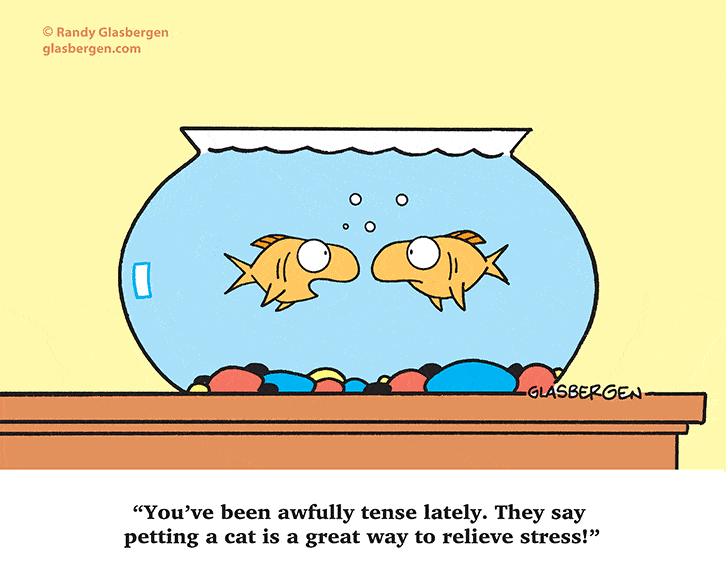
Let them vent a little.
In a lot of cases right now, people don't have many outlets. Where you may have previously vented to a coworker or friend, now you literally can't see them like you used to.
You certainly don't want to complain or share your greatest fears with your children, and if you're trying to be a strong anchor for your family, you may not want to open up too much to your spouse, either.
That means you, as their manager, may be one of the few people that understands what they're going through, and be able to listen right now.
Now, your job is absolutely *not* to be their therapist. However, if you hear about their problems and challenges you can point them towards actionable ways to resolve their issues (like all the things in this post today). That may include starting to see a therapist, which fortunately there is less of a stigma for today than there has been in the past.
Lots of hot takes on the future of (remote) work, but I haven't seen much research or discussion yet on how shifting to a majority remote work force affects our psychological needs. pic.twitter.com/e1BBowbR5Q
— Rei Wang (@heyreiwang) May 8, 2020
Rei Wang captures this challenge well with her tweet about Maslow's Hierarchy of needs above. Quarantine has shattered many people's middle layers of safety, belonging, and esteem. It's little wonder employee burnout is affecting many organizations now.
Taking some time to ask them how they're really doing, and then listening intently can be more of a relief than you can imagine.
In fact, PhD Neuroscientist Jud Brewer writes in the NY Times that, "Just by taking a moment to pause and ask the question, we give our prefrontal cortex a chance to come back online and do what it does best: think."
Help your team manage their anxiety by giving them a safe place to talk about it, and then take action to relieve it going forward.
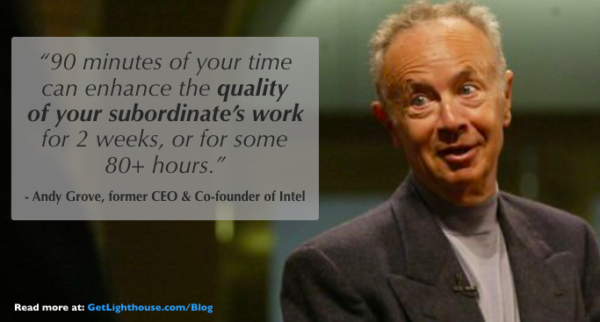
Talk about these in your regular 1 on 1s
You are having weekly or biweekly 1 on 1s with your team, right?
Seriously. If you're not meeting with them and checking how they're doing that often, you're being neglectful.
So much is changing week to week in today's world, and there's so much uncertainty, you need to be there for your team.
And best of all, if you do have this time on the calendar, you don't need to freak them out with a, "Hey - when do you have time to chat?" and give them a heart attack.
Why don’t bosses ever tell you why they want to talk pic.twitter.com/RrNueUqm3q
— Cassidy (@cassidoo) August 30, 2019
Just because you are okay does *not* mean they are.
Everyone's lives are in different states right now based on a variety of factors depending where they live, who they live with, health challenges, and how their job is affected by the economy.
Realize that especially remote you have many fewer clues about how they're feeling. While in the office you could see the stress on their face, them coming in early or late, or overhear things they say that are warning signs, you have to proactively get those when you're all remote.
As investor and serial entrepreneur Elad Gill puts it:
"While many founders thrive on unpredictability, most employees crave stability. Particularly in times like these it is important for people to feel safe and secure. Employee stability may include creating and communicating the following:
Financial stability of the company. Explain cash position, customers, and how the company is going to bridge the COVID-19 recession.
COVID plans and policies. People have uncertainty about whether they can go back into the office and under what conditions to do so. You can put together a plan around office reopening. Some companies have told employees that they will have the *option* to work from home through e.g. September, so employees can plan out a few months of their life in advance. Each state has its own requirements for businesses to reopen so this can get complicated if you are a larger company or deal with manufacturing.
Build ties. Bonds help in times of adversity. Can you do a zoom-based speaker series? Drinks for the team? Think of ways to get people together or bonding in small groups."
By taking time to talk about employee burnout, and helping them navigate the challenges unique to each of your team member's situations, you can prevent or help in reversing work burnout.
Further Reading:
If you want to further support your team in these times read some of these posts:
- Ask these crisis leadership questions to engage your team in solving your biggest problems right now.
- Are you aware of how organizational problems appear, and what is the solution to fix them?
- If you have to do layoffs, do them the right way by following these experts' advice.
- Use these approaches to have a happy team, even in a recession.
- If you aren't having 1 on 1s, start them right now, and learn everything you need to know about 1 on 1s here.
- And if you're still working to get the hang of remote work, follow these 11 essential tips for managing remote employees.




